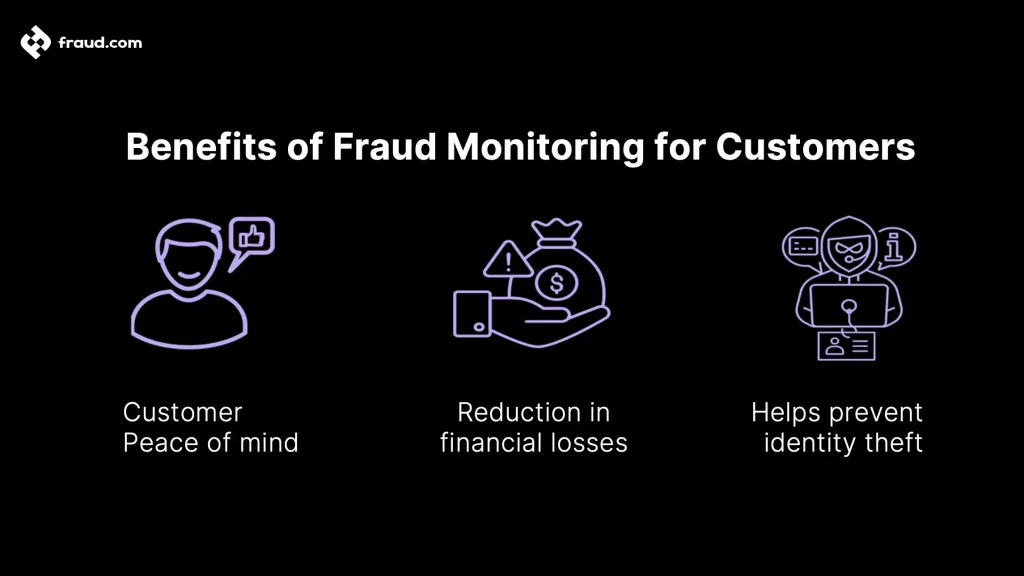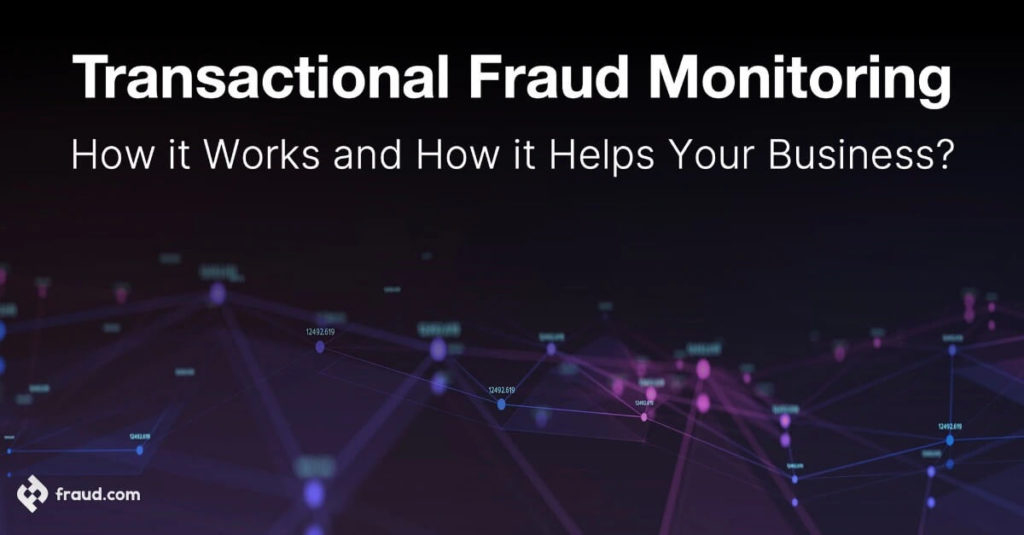As the world becomes increasingly dependent on the Internet, so do businesses. From the rise of the Internet of Things to eCommerce and online banking continued growth, there’s ample of opportunities for businesses to take advantage of digital tools and platforms. Unfortunately, this growth also led to more opportunities for fraudsters to commit fraud.
As such, many business owners now realise the importance of fraud monitoring. This post will explore the purpose of fraud monitoring, how it works, and some benefits it can offer your business.
Table of Contents
ToggleWhat is Fraud Monitoring?
Fraud monitoring technology uses a combination of AI, machine learning, and rules-based systems to detect fraud. It takes into account various data points, effectively creating a “profile” of what fraudulent activity looks like. This profile is then used to flag suspicious behaviour so that it can be investigated.
Most fraud monitoring solutions do this continuously and in real-time, which is critical for preventing fraudsters from causing damage to your business and customers. This software usually uses APIs to integrate with your various business systems, making it easy to protect your customers and your bottom line.
In essence, fraud monitoring is like having a virtual security guard on duty 24/7, 365 days a year. It’s a critical tool for any business that wants to protect itself from cybercrime and fraud. It covers all aspects of fraud, from internal fraud and payment fraud to application fraud and transaction fraud.
How Does the System Work After the Fraud is Discovered?
Fraud detection is the basis of any fraud monitoring system. The ultimate goal isn’t to deter fraudsters from trying to commit fraud because that’s impossible. Any time there is an opportunity to make money dishonestly, a fraudster will try to do it.
The goal is instead to make it so difficult and time-consuming that they’ll move on to an easier target. While that’s unfortunate for those who aren’t prepared, it’s a much better outcome than being taken advantage of. So, what exactly does fraud detection entail?
There are two main types of fraud detection: rules-based and machine learning.
Rules-based fraud detection relies on a set of predetermined rules or conditions that, when met, will trigger an alert. For example, you might have a rule that says any order over $1,000 must be manually reviewed before it’s processed.
This is a simple and effective way to catch certain types of fraud, but it’s not fool proof. Fraudsters are always coming up with new ways to commit fraud, so rules-based systems must be constantly updated.
Machine learning fraud detection, on the other hand, relies on algorithms that learn from data. The more data they have, the better they get at detecting fraud. It’s a much more sophisticated approach since it can identify patterns that humans would never be able to spot.
The best fraud monitoring systems use a combination of both rules-based and machine-learning fraud detection. By using incredibly large datasets, machine learning models can detect fraud with high accuracy.
Once the system flags a discovered fraud, business owners can take manual action if needed. They might cancel the transaction, refund the legitimate customer’s money, and block the user from future access to their account. In some cases, they might also choose to pursue legal action.
Benefits of Fraud Monitoring for Customers
Fraud monitoring doesn’t just benefit businesses—it also protects customers. After all, the customer’s money is at stake when fraudsters strike. Here are a few ways advantages of fraud monitoring for your customers:

Gives customers peace of mind:
A great benefit of fraud monitoring technology is that it gives customers peace of mind. When you know your information is protected, it’s easier to relax and enjoy your purchase. That can go a long way in creating a loyal customer base and satisfaction.
Reduces the risk of financial losses:
If a customer’s information is stolen, they could suffer serious financial losses. While they might recover some of that money through their bank or insurance company, that process can be long and stressful. With fraud monitoring in place, the risk of financial losses is significantly reduced.
Helps prevent identity theft:
One of the most important benefits of fraud monitoring is that it helps prevent identity theft. By keeping a close eye on customer activity, businesses can quickly spot when someone is trying to use someone else’s information. Identity theft is a severe problem that can have lasting repercussions, so this is a significant advantage for customers.
Types of Fraud Monitoring
Before implementing a fraud monitoring system, it’s essential to understand the different types of solutions. That way, you can tailor your approach to protect your business better. Here are a few of the most common types of fraud monitoring:
Continuous fraud monitoring
Continuous fraud monitoring is a proactive approach to fraud prevention. It involves constant and ongoing monitoring customer activity for signs of fraud. If something looks suspicious, the system will flag it for further review. This type of fraud monitoring encompasses all aspects of the customer journey, from account opening to transaction processing.
Continuous transaction monitoring
Continuous transaction monitoring is like continuous fraud monitoring but focuses specifically on transactions. However, instead of only watching the end transaction, this type of fraud monitoring also looks at the journey leading up to the purchase. From login to payment, analytics are used to identify any red flags.
Continuous session monitoring
Even if a transaction is legitimate, it could be part of a larger fraud scheme. In order to improve risk management and to catch these types of schemes, some businesses use continuous session monitoring. This system monitors customer activity across all channels (e.g., web, mobile) and looks for patterns that could indicate fraud.
For example, a session that began on a mobile device but was completed on a desktop computer might be flagged as suspicious. Likewise, a session in which the customer’s location or IP address suddenly changes could also be cause for concern.
Note that session monitoring can go even deeper, such as monitoring the customer’s mouse movements or keystrokes.
Other Fraud Monitoring Types
In addition to the three types of fraud monitoring described above, there are a few other fraud monitoring solutions worth mentioning. Data mining is a type of fraud detection that uses artificial intelligence to look for patterns in customer data. It can be useful to predict future fraudulent activity or identify existing fraud.
Finally, brand monitoring is another type of fraud monitoring often used in e-commerce. This system monitors your brand mentions online and looks for anything that could damage your reputation. It might include spam reviews, impersonators running phishing scams, or counterfeit products.
There are many fraud monitoring systems, each with its advantages. Understanding the different options allows you to choose the right solution for your business.
Fraud Detection and Monitoring with Machine Learning and Artificial Intelligence
Fraud monitoring with machine learning refers to any method of using machine learning algorithms to detect or prevent fraud. Machine learning is artificial intelligence that allows computers to learn from data without being explicitly programmed. In the case of fraud detection, you can use machine learning to identify patterns in data that are indicative of fraud automatically.
Machine learning is well-suited to fraud detection because of it versatility. Machine learning algorithms can distinguish between regular behaviour and fraudulent behaviour that would be difficult for humans to spot. By analysing historical data, machine learning can also identify new types of fraud as they emerge.
For example, a machine learning system might detect fraudsters using multiple accounts to make small purchases in an attempt to avoid detection. This type of fraud can be challenging to detect if the scammers don’t break any rules explicitly. However, by looking at patterns in the data, a machine learning system can identify this type of fraud and flag it for further investigation.
Fraud Monitoring and Compliance
Not only will machine learning improve your fraud detection capabilities, but it can also help you meet compliance requirements. The General Data Protection Regulation (GDPR) requires businesses to take steps to protect customer data.
Fraud monitoring with machine learning can help you comply with GDPR by ensuring that only authorised users can access customer data. For instance, you can use machine learning to detect when an employee is trying to access customer data that they shouldn’t have access to.
The Payments Services Directive 2 (PSD2) is another regulation that has implications for fraud monitoring. PSD2 requires businesses to use strong customer authentication (SCA) when customers make online payments. SCA is an extra step in the payment process that helps with identity verification, which fraud monitoring can assist with.
If you fail to comply with either of these regulations, your business could be subject to heavy fines. However, if you use machine learning for fraud detection, you can meet these compliance requirements and improve your fraud detection capabilities simultaneously.
In Which Business Can Fraud Monitoring Be Used?
Although most businesses can benefit from fraud monitoring, some industries are more likely to experience fraud than others. Here are a few examples:
Banking and financial services:
Banking and financial institutions are common targets for fraudsters. Because of this, these businesses are under constant pressure to improve their fraud detection capabilities. You can use fraud monitoring to detect various frauds, including credit card fraud, money laundering, and account takeover.
Crypto
The unregulated nature of the cryptocurrency market makes it a prime target for fraudsters. We’ve seen everything from Ponzi schemes to higher crypto fraud and phishing scams in recent years. There are also many newer hacks that aren’t detectable by traditional means.
Insurance
Insurance fraud costs the industry billions every year. Criminals will set up fake insurance claims or stage accidents to collect money. They might also steal personal information to take out a policy in someone else’s name.
Gaming
The gaming industry is another common target for fraudsters. In-game purchases are often made with real money, making them an attractive target for criminals. Additionally, many games require personal information, such as email addresses and credit card numbers, which fraudsters can use for identity theft.
Our Fraud Monitoring Solution – fcase
fcase is a fraud monitoring software that enables businesses to connect their fraud tools and systems to detect and prevent fraud. The goal of this initiative is to connect various fraud-fighting functions, including customer support and cybersecurity, with anti-fraud operations, automating fraud detection, and monitoring the customer journey.
fcase offers a comprehensive fraud monitoring solution for businesses of all sizes. Companies can monitor all their fraud tools and systems from a central dashboard in real-time, making it easy to manually review flagged suspicious activity and take action quickly. A continuous and adaptive Risk and Trust assessment creates an evolving customer profile, so you can be confident that you know your customers as well as they know themselves.
We also have seamless APIs that integrate with your existing systems, so you can start immediately. Our team of experts is always on hand to help you get the most out of our fraud monitoring solution.
If you’re looking for a fraud monitoring solution that can help you comply with regulations and improve your overall fraud detection capabilities, fcase is the right choice for you. Contact us today to find out more.









